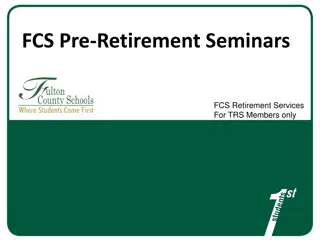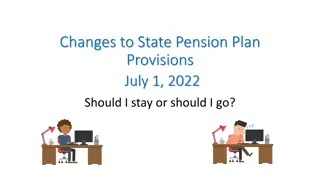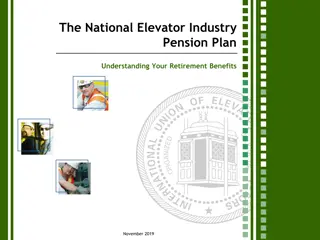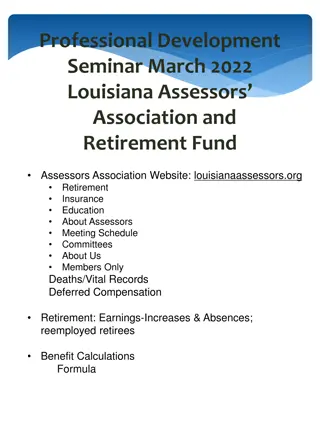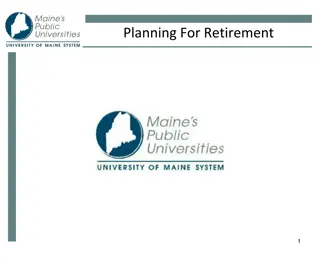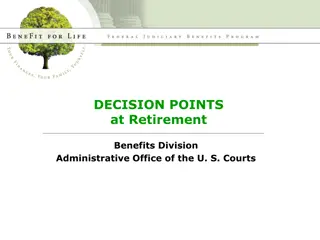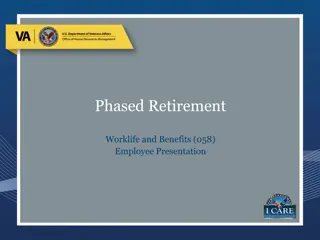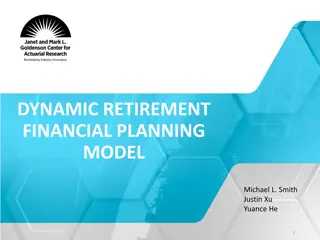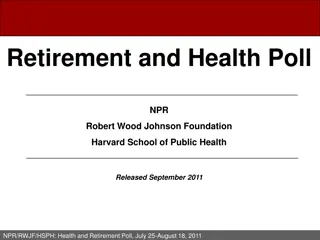Understanding Social Security Retirement Benefits
Learn how to qualify for Social Security retirement benefits, how benefits are calculated based on earnings, when to start receiving benefits, and how working while receiving benefits can affect your payments. Explore online calculators to plan your retirement strategy effectively.
Download Presentation

Please find below an Image/Link to download the presentation.
The content on the website is provided AS IS for your information and personal use only. It may not be sold, licensed, or shared on other websites without obtaining consent from the author. Download presentation by click this link. If you encounter any issues during the download, it is possible that the publisher has removed the file from their server.
E N D
Presentation Transcript
Social Security: With You Through Life s Journey Produced at U.S. taxpayer expense
How Do You Qualify for Retirement Benefits? By earning credits when you work and pay Social Security taxes You need 40 credits (10 years of work) and you must be 62 or older Each $1,640 in earnings gives you one credit You can earn a maximum of 4 credits per year Note: To earn 4 credits in 2023, you must earn at least $6,560. ssa.gov/planners/credits.html SSA.gov
SS Replaces a Portion of Your Work Income $160,200.00 SSA.gov
How Social Security Determines Your Benefit Benefits are based on earnings Step 1 - Your wages are adjusted for changes in wage levels over time Step 2 - Find the monthly average of your 35 highest earnings years Step 3 - Result is average indexed monthly earnings ssa.gov/OACT/COLA/Benefits.html SSA.gov
Benefits Chart by Age A $1000 retirement benefit taken at age 62 would be reduced by 25% 25.83% 26.67% 27.5% 28.33% 29.17% 30% A $500 spouse benefit taken at age 62 would be reduced by 30% 30.83% 31.67% 32.5% 33.33% 34.17% 35% Year of Birth Full Retirement Age 1943-1954 1955 1956 1957 1958 1959 1960 + 66 66 and 2 months 66 and 4 months 66 and 6 months 66 and 8 months 66 and 10 months 67 Reduction is permanent when you take your Benefit prior to Full Retirement Age ssa.gov/oact/quickcalc/earlyretire.html SSA.gov
What Is the Best Age to Start Receiving Social Security Retirement Benefits? Note: This example assumes a benefit of $2,000 at a full retirement age of 67 SSA.gov
Social Securitys Online Calculators ssa.gov/planners/calculators SSA.gov
Working While Receiving Benefits If you earn more, some benefits will be withheld $1 for every $2 If you are You can make up to Under Full Retirement Age The Year Full Retirement Age is Reached Month of Full Retirement Age and Above $21,240/yr. $56,520/yr. before month of full retirement age No Limit $1 for every $3 No Limit Retirement Earnings Test Calculator: ssa.gov/OACT/COLA/RTeffect.html SSA.gov
Will I pay federal taxes on my benefits? If you: file a federal tax return as an "individual" and your combined income* is between $25,000 and $34,000, you may have to pay income tax on up to 50 percent of your benefits. more than $34,000, up to 85 percent of your benefits may be taxable. file a joint return, and you and your spouse have a combined income* that is between $32,000 and $44,000, you may have to pay income tax on up to 50 percent of your benefits more than $44,000, up to 85 percent of your benefits may be taxable. are married and file a separate tax return, you will probably pay taxes on your benefits. SSA.gov
WEP & GPO Windfall Elimination Provision: Applies when you have 40 credits plus a non-covered pension* and you re filing for retirement or disability benefits Government Pension Offset: Applies when you are receiving a non-covered pension* and filing for spouses, widows and widowers benefits *a pension based on work for which you did not pay Social Security taxes ssa.gov/planners/retire/wep.html SSA.gov
What is WEP? A provision that can affect how we calculate your retirement or disability benefit. If you work for an employer who doesn t withhold Social Security taxes from your salary, such as a government agency or an employer in another country, any pension you get from that work can reduce your Social Security benefits. WEP uses a formula to adjust the Social Security benefits for people who receive non covered pensions and qualify for Social Security benefits based on other Social Security covered earnings. ssa.gov/planners/retire/wep.html SSA.gov
The Windfall Elimination Provision (1983) Before 1983, people whose primary job wasn t covered by Social Security had their Social Security benefits calculated as if they were long-term, low-wage workers: They had the advantage of receiving a Social Security benefit representing a higher percentage of their earnings, plus a pension from a job for which they didn t pay Social Security taxes; Congress passed the Windfall Elimination Provision in 1983 to remove that advantage. ssa.gov/planners/retire/wep.html SSA.gov
WEP Calculator If you have a pension from work not covered by Social Security, the online WEP calculator allows you to estimate your Social Security benefit using the information shown on your online Social Security Statement. You also need to enter the monthly amount of your pension that was based on work not covered by Social Security. If you do nothave a non- covered pension, you do not need to use this calculator. ssa.gov/planners/retire/anyPiaWepjs04.html Reminder: When using calculator, use the TAB key when entering earnings. Otherwise, it will use the wrong indexing factor and give an incorrect answer. SSA.gov
Normal Benefit Computation Example (2023) If a person s average indexed monthly earnings (AIME) = $2,500 Then their monthly benefit would be = $1,446.70 90% of first $1,115 ($1,115 x .90 = $1,003.50) $1,115 = $1,003.50 32% of earnings between $1,115 and $6,721 ($2,500 - $1,115 = $1,385) ($1385 x .32 = 443.20) $1,385 = $443.20 15% of earnings over $6,721 $0 $0 Total monthly benefit $2,500 $1,446.70 *Figures in green change every year. SSA.gov
WEP Benefit Computation Example (2023) If a person s average indexed monthly earnings (AIME) = $2,500 Then their monthly benefit would be = $1,446 $889 90% 40% of First $1,115 ($1115 x .40 = $446) $1,115 = $1,003.50 $446.00 32% of earnings between $1,115 and $6,721 ($2,500 - $1,115 = $1,385) ($1385 x .32 = $443.20) 15% of earnings over $6,721 $1,385 = $443.20 $0 $0 Total monthly benefit $2,500 $1446.70 $889.20 SSA.gov
Exception to the WEP Years of Substantial Earnings % of First Factor You Receive 30 or more 29 28 27 26 25 24 23 22 21 20 or fewer 90 85 80 75 70 65 60 55 50 45 40 SSA.gov
Yearly EarningsAmount Considered Substantial In 2023, gross earnings of $29,700.00/yr. or more counts as substantial for WEP purposes. SSA.gov
Who Can Get Benefits As A Spouse? Comparable lifetime SS wage earners will probably not be eligible : Eligible only if your own SS is less than 50% of theirs; You would get your SS plus an amount on your spouse which would bring your total benefit to be equal to of your spouses s; Example: Your spouse s SS benefit = $1000/mo. Your SS benefit = $400/mo. Combined max you can receive is $500/mo. ( of your spouse s) You would receive your $400 + $100 on spouse = $500 ( of spouse s) Does not reduce spouse s benefit amount; Spouse must be collecting for you to draw on their record: Deemed filing Applies when filing at any age for people who turned age 62 after January 1, 2016. ssa.gov/planners/retire/yourspouse.html SSA.gov
Why are Spouse and Survivor Benefits Reduced? Benefits we pay to spouses and widow(er) s are dependent benefits, originally designed to compensate spouses who stayed home to raise a family and were financially dependent on the working spouse. The law requires a $ for $ offset on any spousal benefit due after your own SS benefit is counted. SocialSecurity.gov
Spouse vs. Surviving Spouse Benefits Spouse (living) Surviving Spouse (deceased) May start as early as age 60 or as early as 50 if disabled 71.5% at age 60, increases each month you wait 100% if you start at FRA or later May start as early as age 62 50% if you wait until FRA or later Less than 50% if you start before FRA (reduction for each month you take benefit early) Remember: If you are working & are not FRA, earnings may affect ability to draw benefits. ssa.gov/planners/survivors/ifyou.html#h6 SSA.gov
Only widows(ers) can take a benefit (on own record or on deceased spouse record) then switch to a higher benefit later. Example: You can take a widows(ers) benefit as early as 60, then switch to your own retirement record as soon as that benefit amount is higher. OR You can take your retirement as early as age 62, then switch to surviving spouse s at full retirement age if benefit is higher. Remember: If you are working & are not FRA, earnings may affect ability to draw benefits. SSA.gov
Benefits for Divorced Spouses You might receive benefits on your former spouse's record (even if he/she has remarried) if: Benefit you would receive based on your own SS work is less than 50% of theirs and: Marriage lasted at least 10 years; You are unmarried; You are age 62 or older; Your ex-spouse is at least 62 & eligible for SS retirement or disability benefits (he/she does not have to be collecting). ssa.gov/planners/retire/yourdivspouse.html SSA.gov
Government Pension Offset (GPO) If you receive a government pension based on work not covered by Social Security, your Social Security spouses, widows, or widowers benefit may be reduced. 2/3 of the gov pension is used to determine if you are eligible for a benefit on your spouse s SS record. SocialSecurity.gov
How GPO works 2/3 of amount of non-covered pension will be used to reduce the Social Security spouse s benefit. Example: $2,100 non-covered pension, 2/3 = $1,400 Social Security spouse s benefits = $1,150 No benefit payable by Social Security Our Online GPO calculator allows you to estimate your Social Security benefit. ssa.gov/calc-gpo SocialSecurity.gov
How GPO works (continued) 2/3 of amount of non-covered pension will be used to reduce the Social Security widow or widower s benefit. Example: $2,100 non-covered pension, 2/3 = $1,400 Social Security widow or widower s benefits = $2,300 Widow or widower s benefit after GPO = $900 Our Online GPO calculator allows you to estimate your Social Security benefit. ssa.gov/calc-gpo SocialSecurity.gov
my Social Security ssa.gov/myaccount SocialSecurity.gov
my Social Security Services If you do not receive benefits, you can: Request a replacement Social Security card Retirement benefit estimates at different ages or dates when you want to start receiving benefits; View possible spouse s benefits; When you file online: check the status of your application or appeal; Get your Social Security Statement to review: Estimates of your future retirement, disability, and survivor benefits; Your earnings record, to verify the amounts that we posted are correct; and The estimated Social Security and Medicare taxes you ve paid. ssa.gov/myaccount/what.html SSA.gov
Social Securiaaty Statement SSA.gov
my Social Security Services If you receive benefits or have Medicare, you can: Request a replacement Social Security card; Get a benefit verification letter as proof that you are getting benefits; Check your benefit and payment information and your earnings record; Change your address and phone number; Start or change direct deposit of your benefit payment; Submit your advance designation of representative payee request; Request a replacement Medicare card; and Get a replacement SSA-1099 or SSA-1042S for tax season. ssa.gov/myaccount/what.html SSA.gov
How to Apply for Benefits File online for Retirement, Spouse, Disability, or Medicare Only If you are disabled, you can file for Retirement and Disability with same application if you are at least 62 but not yet FRA. Survivor* application is not available online. Schedule phone appointment at 1-800-772-1213, 8 a.m. 7 p.m. Monday through Friday. Schedule in-office appointment at 1-800-772-1213. *Child and survivor claims can only be done by phone or in the office. SSA.gov
Medicare Medicare Advantage (aka Part C) Part A (Hospital Insurance) Part B (Medical Insurance) Most plans include: Part D (Prescription Drug Plan) Extra Benefits (e.g., vision, hearing, dental, and more) Some plans also include: Lower out-of-pocket costs Original Medicare Part A (Hospital Insurance) Part B (Medical Insurance) You can add: Part D (Prescription Drug Plan) You can also add: Supplemental insurance coverage (Medigap) Medicare.gov SSA.gov
Medicare Enrollment Periods Enrollment Period: Initial Enrollment Period Your first opportunity to enroll When the period occurs: 3 months before you turn age 65, the month you turn age 65, and 3 months after you turn age 65 Annually, January 1 March 31 General Enrollment Period Special Enrollment Period During any month you remain covered under the group health plan and your, or your spouse's, current employment continues; or In the eight-month period that begins with the month your group health plan coverage or the current employment it is based on ends, whichever comes first. SSA.gov
Medicare Part B Coverage - IEP Beginning in 2023, if you enroll in the month of your Initial Enrollment Period: One to three months before you reach age 65 The month you reach age 65, or one to three months after you reach age 65 Your Part B Medicare coverage starts: The month you turn age 65 The first day of the month after you sign up In 2023 Part B Premium is $164.90/mo. SSA.gov
Medicare Part B Coverage - GEP Beginning in 2023, if you enroll in the month of the General Enrollment Period: January 1 to March 31 (You might pay a late enrollment penalty) Your Part B Medicare coverage starts: The first day of the month after you sign up SSA.gov
Medicare Part B Coverage - SEP If you enroll in the month of your Special Enrollment Period: Any time while you or your spouse have a group health plan based on current employment, or during the first full month you are no longer covered or employed During any of the remaining 7 months of the SEP Your Part B Medicare coverage starts: On the first day of the month you enroll, or By your choice, on the first day of any of the following 3 months The first day of the month after you sign up. SSA.gov
Medicare Standard Part B Premiums for 2023 If you re single and file an individual tax return, or married and file a joint tax return: Modified Adjusted Gross Income (MAGI) Part B monthly premium amount Prescription drug plan monthly premium amount Individuals with a MAGI of $97,000 or less Married couples with a MAGI of $194,000 or less 2023 standard premium = $164.90 Your plan premium + $0 Individuals with a MAGI above $97,000 up to $123,000 Married couples with a MAGI above $194,000 up to $246,000 Standard premium + $65.90 Your plan premium + $12.20 Individuals with a MAGI above $123,000 up to $153,000 Married couples with a MAGI above $246,000 up to $306,000 Standard premium + $164.80 Your plan premium + $31.50 Individuals with a MAGI above $153,000 up to $183,000 Married couples with a MAGI above $306,000 up to $366,000 Standard premium + $263.70 Your plan premium + $50.70 Individuals with a MAGI above $183,000 up to $500,000 Married couples with a MAGI above $366,000 up to $750,000 Standard premium + $362.60 Your plan premium + $70.00 Individuals with a MAGI equal to or greater than $500,000 Married couples with a MAGI equal to or greater than $750,000 Standard premium + $395.60 Your plan premium + $76.40 SSA.gov
Medicare.gov 1-800-MEDICARE or Medicare.gov SSA.gov
Extra Help with Medicare Prescription Drug Plan Costs Medicare beneficiaries may qualify for Extra Help with Medicare prescription drug plan costs Needs-based program for people with limited income and resources Extra Help may be worth an estimated $5,100 per year ssa.gov/extrahelp SSA.gov
Follow Us on Social Media! @SocialSecurity SSA.gov
Social Security: With You Through Life s Journey www.socialsecurity.gov SSA.gov Produced at U.S. taxpayer expense





